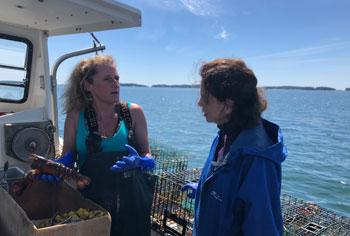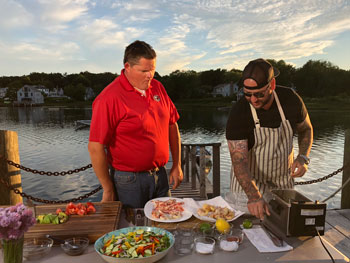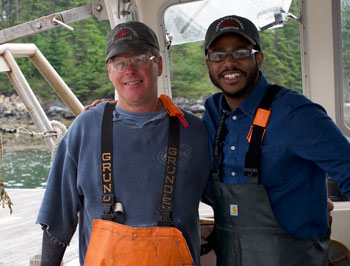Lobster Marketing Group Leverages Chefs as Food Influencers
by Laurie Schreiber

South Thomaston lobsterman Krista Tripp, left, hosted food expert Dana Cowin on her lobsterboat as part of the Maine Lobster Marketing Collaborative’s latest promotional initiative. Photo courtesy Maine Lobster Marketing Collaborative.
PORTLAND—The Maine Lobster Marketing Collaborative’s latest promotional initiative on behalf of Maine’s lobster industry is a live broadcast from New York City.
At press time, the broadcast was scheduled to stream online on July 16, so viewers around the globe could tune in. The focus would be on Maine lobster as an iconic seafood, with a discussion of how it’s harvested and sustainability measures that keep the stock healthy. It would feature four food experts who spent time recently in Maine to experience the industry first-hand: Dana Cowin, the former editor-in-chief of Food & Wine Magazine and hosts the “Speaking Broadly” podcast on Heritage Radio; Boston chef Karen Akunowicz; Washington, D.C., chef Kwame Onwuachi; and Chicago chef Jimmy Papadopoulos.
The broadcast is the next phase of the collaborative’s strategy of utilizing chefs as food influencers, said MLMC Executive Director Matt Jacobson.
“If you can get them on your side and interested, that begets media coverage and it begets more chefs and people interested in Maine lobster,” he said. “That’s the genesis. And that’s been our cornerstone since we started.”
Maine After Midnight
events generated
“a ton of buzz around
Maine lobster.”
The MLMC was founded in 2013 and became operational in 2014, funded, through a license surcharge, by Maine lobster harvesters, dealers and processors to grow demand for whole live lobster and value-added products. In 2015, marketing agency Weber Shandwick, headquartered in New York City, was retained to develop and deploy marketing strategies. Weber Shandwick developed a marketing program to identify Maine soft-shell lobster as “new shell.” The program focused on U.S. markets, as opposed to overseas, as a more efficient use of dollars. The MLMC developed a new website and social channels; built an online community and a library of photos and videos; engaged food and industry media and influencers to share the industry’s story; introduced Maine new shell lobster to key audiences through one-on-one meetings with top chefs, conferences, and culinary events; and created educational resources for culinary and dealer use in domestic and international markets. Key to the program is pairing lobstermen with chefs. MLMC created an events program called Maine After Midnight, held around the country, with lobstermen talking with chefs and visiting restaurants. And MLMC has been reaching out to media to scale the lobstermen/chef interactions. According to data that Jacobson presented to Maine’s lobster zone councils last December, the marketing program:

Kennebunkport lobsterman Chris Welch, left, hosted chef Jimmy Papadopoulos on on his lobsterboat as part of the Maine Lobster Marketing Collaborative’s latest promotional initiative. Photo courtesy Maine Lobster Marketing Collaborative.
• reached 25 million social media users—130 times the number of readers of USA Today;
• generated more than 5 million likes, comments, clicks, and shares;
• drove 2.5 million visitors to MLMC’s website;
• increased social media mentions of “Maine lobster” by 433 percent since efforts began;
• secured 3.2 billion media impressions with an ad value of $21 million.
The Maine After Midnight events generated “a ton of buzz around Maine lobster,” Jacobson said, “but we thought this year it was time to take another step and keep the concept fresh. One of the trends we’ve noticed in media is the gravitation to live broadcasts, whether it be online or on TV. Especially these days, you see more and more consumers on their phone, their tablets, their screens – clicking on something live is attractive. So we’ve figured out a way to couple that trend with our mission of creating more buzz around Maine lobster.”
To that end, MLMC and Weber Shandwick identified the four food experts, headlined by Cowin, and brought all four to Maine, pairing them with lobstermen who took them on their boats and demonstrated the industry first-hand. Afterward, the food experts cooked what was caught. Everything was taped and ultimately edited to create 30-minute videos, Jacobson explained.
The live broadcast brought the participants together at a Maine After Midnight event. And all of that content will be used all summer for different media opportunities, he said.

Islesford lobsterman Bruce Fernald hosted chef Kwame Onwuachi on his lobsterboat as part of the Maine Lobster Marketåing Collaborative’s latest promotional initiative. Photo courtesy Maine Lobster Marketing Collaborative.
It’s difficult to measure tangible outcomes of the initiatives from a financial perspective, because of the complexity of the supply chain, Jacobson said. Maine has over 300 lobster suppliers and dealers, all privately held companies, and none share their data, he said.
“We knew that going in,” he said. “I’ve talked with my counterparts with other marketing boards around the country and they have the same problem—it’s just difficult to get information from companies that don’t have to share it.”
However, anecdotally, fishermen appear to be pleased with the results so far, he said. During its reauthorization process last year, every lobster zone council supported the MLMC, and all but one did so unanimously.
“So from the lobstermen’s point of view, it’s working,” he said.
The billions of media impressions alone, he said, is worth far more than the MLMC’s yearly budget of $2.2 million.
“So we think we’re getting a bang for our buck,” he said.
